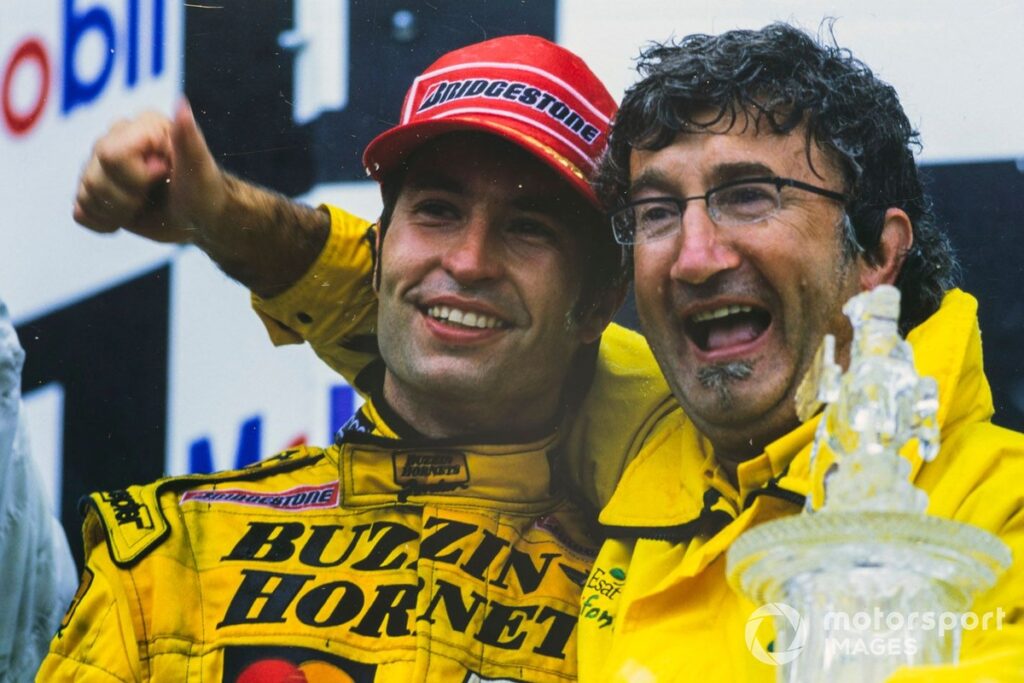Eddie Jordan Racing became a big player in junior single-seaters prior to the Jordan squad arriving in Formula 1 in 1991.
Before becoming the Midland-owned MF1 Racing for 2006, Jordan built up a cult following, helped launch the careers of several drivers and briefly became a championship contender.
Here’s our choice of the squad’s finest moments.
10. Winning the 1987 British F3 title
Victory at Silverstone part of early flurry of wins for Herbert en route to British F3 crown
Photo by: Getty Images
Eddie Jordan Racing had come close to the British F3 title before – most notably with Martin Brundle in 1983 – but hadn’t quite made it. Until, that was, Jordan signed Johnny Herbert to drive his Dave Benbow-engineered Reynard-Volkswagen for the 1987 campaign.
Herbert took pole by over a second at the Thruxton opener, won by more than seven seconds despite a poor start, and added three more victories over the next four races. Thereafter the opposition caught up and Herbert was limited to only one win over the remaining 13 rounds but, by then, he was realistically too far ahead.
Herbert actually clinched the title in inauspicious circumstances. He clashed with poleman Bertrand Gachot on the opening lap of the penultimate round at Spa, won by Damon Hill, but still ended the day out of reach of rivals Thomas Danielsson and Gachot.
“Eddie Jordan finally quashed a jinx and took a most deserved title,” reported Autosport’s Tony Dodgins. “The team could not have chosen a more competitive year to break its F3 duck.”
That success also set up both Herbert and EJR for the 1988 International F3000 season, in which they gave Reynard a debut victory in the Jerez season opener…
INSIGHT: Johnny Herbert on Eddie Jordan
9. Alesi’s 1989 F3000 crown
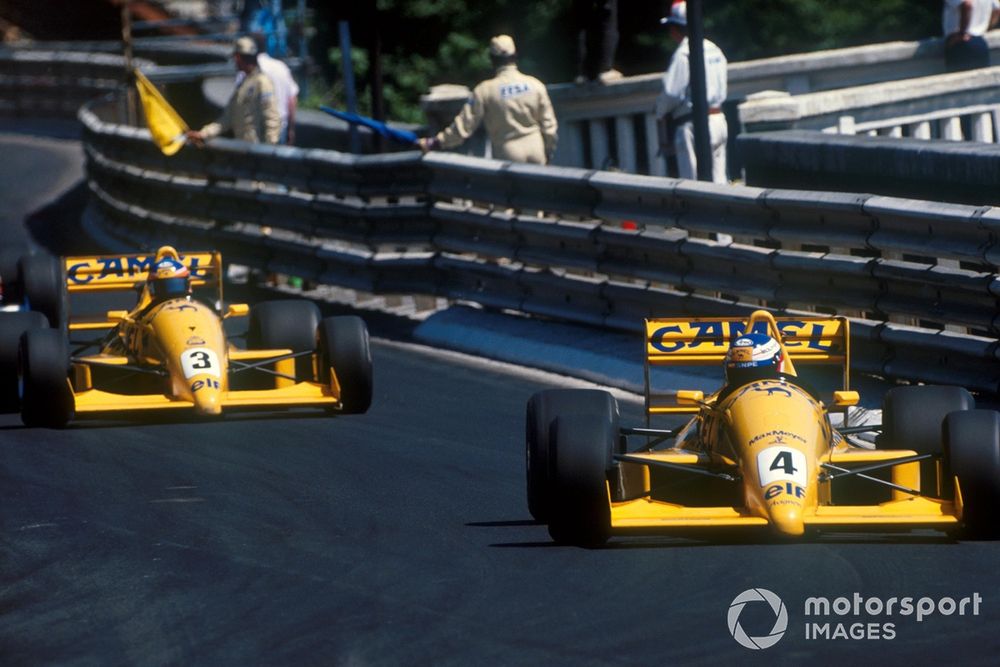
Race winner Alesi leads team-mate Donnelly at pivotal Pau F3000 round
Photo by: Sutton Images
By 1989, EJR was one of the major F3000 players and had Jean Alesi (after a disappointing rookie campaign) and Martin Donnelly (already a race winner) lined up to drive the Camel-backed Reynards.
Donnelly initially had the edge on pace but had engine trouble at the opener and then lost Vallelunga victory after being disqualified for using a revised nosecone. Instead, Alesi got his first win in round three at Pau, after the duo had set the same qualifying time, on a weekend Autosport described as “undoubtedly the turning point of the year”.
More misfortune for Donnelly, combined with consistent scoring for Alesi and a challenge from the DAMS team, meant the Briton was never a title contender. Although Donnelly beat Alesi in an EJR 1-2 at Brands Hatch, the Frenchman reeled off wins at Birmingham’s Superprix and Spa. He sealed the deal with sixth at Le Mans, round nine of 10.
“EJR got the job done and claimed its biggest championship success since the team’s formation,” concluded Autosport.
Alesi’s career had been resurrected to such a degree that he skipped the final round to compete in the Japanese Grand Prix for Tyrrell, having finished fourth on his debut in France. Not for the first or last time, Jordan had helped the career of a future F1 winner.
INSIGHT: Top 10 F1 one-hit wonders
8. 1991 Canadian GP, Montreal
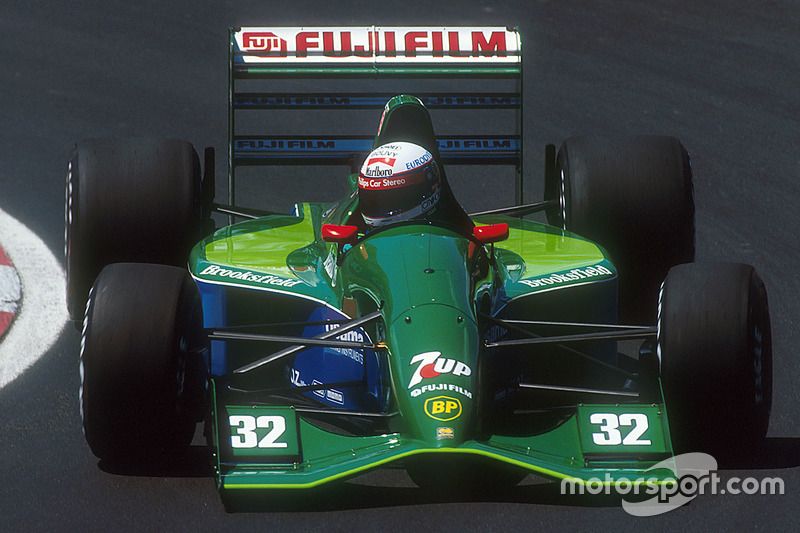
Gachot followed team-mate de Cesaris home for Jordan’s breakthrough double points-scoring finish in Montreal
Photo by: Motorsport Images
Having run Eddie Irvine (who won a round) and Heinz-Harald Frentzen (who didn’t) in F3000 during 1990, Jordan stepped into F1 with the experienced Andrea de Cesaris and Gachot the following year.
Gary Anderson’s Ford HB-powered 191 was a good car, a fact that was underlined as early as round five of the 1991 campaign. De Cesaris, who arguably never drove better than when he was at Jordan, qualified 11th for the Canadian GP, with Gachot 14th.
Both made early stops after their initial tyre choice proved too soft in the opening stint, but then steadily rose up the order.
Despite starting to lose gears, de Cesaris held his nerve to run fifth in the closing stages, with Gachot just behind having survived a spin and nursing his own gearbox gremlins. Both then moved up a spot when leader Nigel Mansell’s Williams famously stopped on the final lap.
“The result says a lot about the people in our team and the companies we work with,” said Jordan after his team’s first F1 points finishes. “Hopefully we can now look forward to leaving pre-qualifying behind us.”
As a newcomer, Jordan had to pre-qualify for a chance to make it onto the 26-car grid in the first half of the season but easily did well enough to avoid having to do so in the latter half of the campaign.
INSIGHT: Best looking F1 cars
7. 1994 Pacific GP, Aida

Barrichello celebrates after delivering the Jordan squad’s first Formula 1 podium
Photo by: Sutton Images
This could have been an entry on the 1993 European GP at Donington Park. One of Ayrton Senna’s greatest drives, the race also showcased the talents of another Brazilian.
INSIGHT: Ayrton Senna’s greatest F1 drives
In just his third world championship GP, Rubens Barrichello rose from 12th to briefly run second in the rain-hit race. He was holding third with less than 10 minutes to go when his Jordan 193’s fuel pressure dropped and he was classified 10th.
Fortunately, the future Ferrari driver would still give Jordan its first F1 podium. After a couple of tough years, Jordan was stronger in 1994 and Barrichello made a great start from eighth to run fifth over a dramatic opening lap in the Pacific GP at Aida.
He rose to fourth when Mika Hakkinen’s McLaren had its second clash with a Williams in the race, resulting in a spin for Hill. Hill soon repassed the Jordan but Barrichello was aided when Hakkinen finally retired with gearbox trouble.
The Jordan briefly rose as high as second amid the pitstops but was running a more representative fourth when Hill’s transmission failed. Under pressure from Martin Brundle’s faster McLaren, Barrichello briefly stalled at his second stop but got third back again when the McLaren’s Peugeot engine cried enough.
Barrichello finished a lap down and had needed some luck but, in the team’s 50th GP, that first podium was still very much deserved.
6. 1994 Belgian GP, Spa
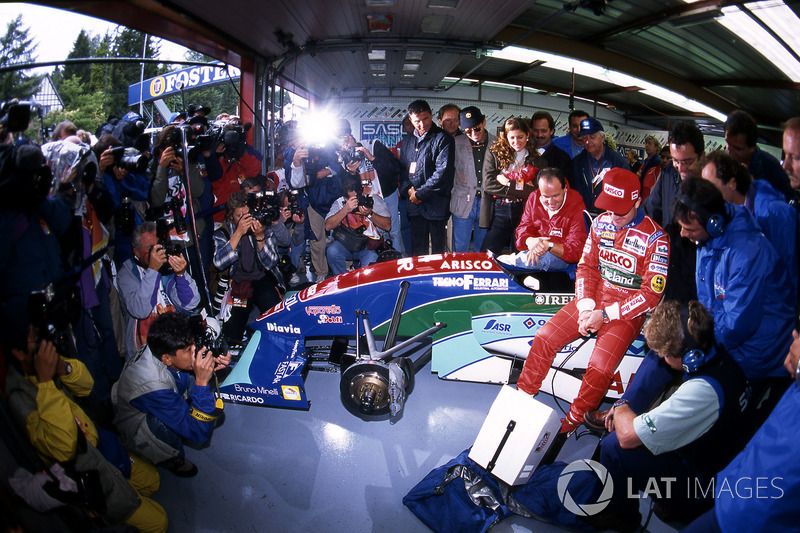
Tense wait at Spa for Barrichello and Jordan, watching the timing screen ahead of confirmation of pole position
Photo by: Sutton Images
Amid F1’s tumultuous 1994 season, Jordan’s 194 was often in the hunt for points and Barrichello became a consistent top-10 contender in qualifying following the San Marino crash that put him in hospital. Fifth on the grid in Spain was his best when the F1 circus headed to Spa, which included a crude chicane at Eau Rouge following the deaths of Roland Ratzenberger and Senna at Imola.
A wet-but-drying Friday qualifying session gave Barrichello the chance to top the times. He did so by gambling on slicks in the closing moments of the session as the track was at its driest. He stopped the clock in 2m21.163s to beat Michael Schumacher’s Benetton by 0.331s, while the wets-shod Jordan of Irvine was fourth, 0.911s off pole.
“The new chicane and the Bus Stop were really slippery, but slicks were the right way to go,” said Barrichello. “Just.”
Saturday qualifying was wet and Barrichello had to wait it out before his – and Jordan’s – first F1 pole was confirmed. “Watching that screen was more tiring than driving,” he said. “I wasn’t going to run because I didn’t want to help dry the track.”
Barrichello made a good start in the GP but fell to third on the opening lap. He continued to drop back in the dry race, partly due to being fuelled heavy for a planned one-stop strategy, and later spun off, but another milestone had already been reached.
5. 1999 French GP, Magny-Cours
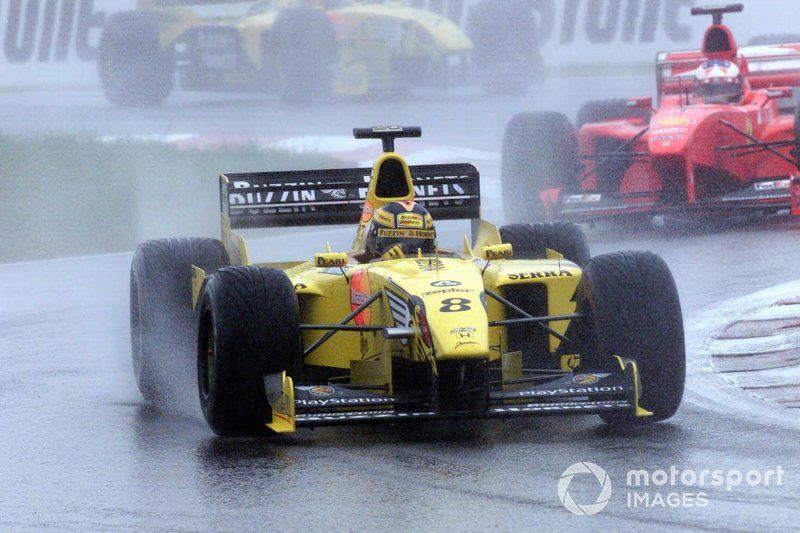
Clever strategy at a wet Magny-Cours helped Frentzen deliver the Jordan team’s second GP victory
Photo by: Charles Coates / Motorsport Images
Jordan brought the best out of Frentzen and a combination of the 199’s pace and mistakes at Ferrari and McLaren kept the German in 1999 title contention. A clever strategy in a rain-affected Magny-Cours contest helped Frentzen to his – and Jordan’s – second GP victory.
A wet qualifying session had caught out the top runners and Frentzen lined up fifth, with the Stewart of Barrichello and Alesi’s Sauber on the front row. Frentzen, still recovering from a nasty shunt in Canada, moved up to fourth on a dry opening lap and gained another spot when David Coulthard’s leading McLaren broke.
Frentzen lost out to a flying Hakkinen – up from 14th – on lap 15 of 72, before rain arrived. As the field came in for wet tyres and the safety car was summoned, Alesi skated off, so that Frentzen was third at the restart.
That became second when Hakkinen spun trying to take the lead, only for Michael Schumacher’s Ferrari to come by on its way to the front. But the Ferrari soon hit electrical trouble, elevating Frentzen until Hakkinen again overtook him in a roller-coaster race.
On lap 65 both new leader Hakkinen and Barrichello came in for their final fuel stops. But Frentzen did not – Jordan had fuelled him heavily at his stop to change to wet tyres and was taking a gamble.
The team was concerned Frentzen wouldn’t make it to the flag, but that long safety car period when the conditions were at their worst helped and the Jordan crossed the line 11.1s ahead of Hakkinen.
4. 2003 Brazilian GP, Interlagos
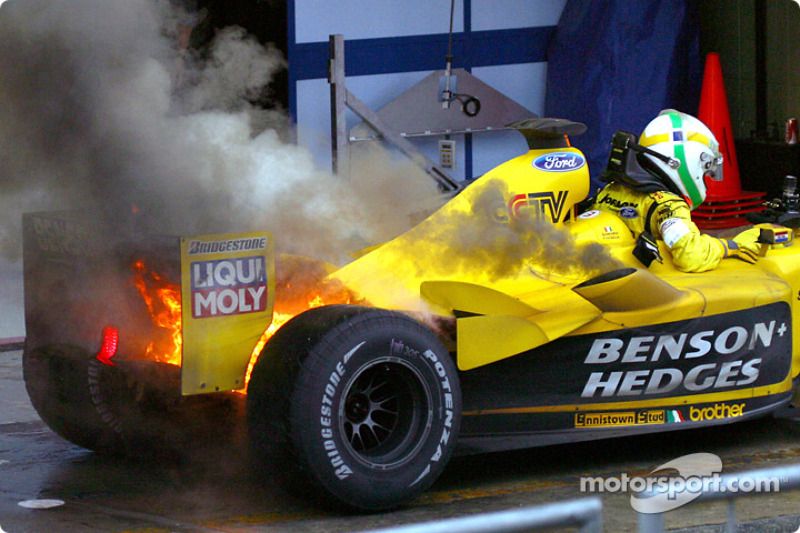
The saga of Fisichella’s fortuitous win at a chaotic Interlagos in 2003 included parc ferme fire
Photo by: Brousseau Photo
Jordan’s decline, with tricky financial and engine situations, was swift and the EJ13 was the second-worst car on the 2003 grid. But another strategy gamble at the Brazilian GP resulted in Jordan scoring its fourth and final F1 victory before it morphed into MF1 Racing, Spyker, Force India, Racing Point and then Aston Martin.
Giancarlo Fisichella qualified an impressive eighth but the first crucial move was Jordan bringing in both him and team-mate Ralph Firman Jr during an early safety car period in the wet conditions to fuel them as long as possible. That put them at the back.
They were still there when Firman suffered a front suspension failure that pitched his Jordan off and he narrowly missed his team-mate. But Fisichella survived and stayed out during the ensuing safety car and round of stops.
Amid concerns that the single-spec wet tyres couldn’t cope with the worst of the conditions, many drivers crashed, including Juan Pablo Montoya and reigning world champion Schumacher. The latter’s Ferrari accident brought out the safety car once more and the race was only briefly green before Jenson Button crashed and full-course yellows flew again.
By the time home hero Barrichello overtook Coulthard’s McLaren for the lead on lap 45, Fisichella had risen to fifth. And when the leading Ferrari ran out of fuel – the legacy of a misfire and telemetry failure – the Jordan moved up again, with Fisichella challenging the Williams of Ralf Schumacher for third.
Both DC and Ralf had to pit for fuel and suddenly Fisichella was challenging Kimi Raikkonen’s McLaren for the lead! When Raikkonen made a small error on lap 54, a Jordan led a GP for the first time in two years.
Raikkonen repassed Fisichella shortly before the race was red-flagged following Fernando Alonso’s huge crash. Raikkonen was initially announced as the winner, while Fisichella’s car set itself briefly on fire(!), but an FIA investigation following a Jordan appeal showed that the results should have been declared at the end of lap 54 – the one lap on which the Italian was ahead.
Jordan hadn’t scored a podium finish for more than two years and would manage only one more in F1. Tiago Monteiro was the best non-Ferrari in the farcical 2005 United States GP in which only six Bridgestone-shod cars started thanks to Michelin tyre concerns.
INSIGHT: Top 10 worst F1 cars to win a GP
3. 1991 Belgian GP, Spa
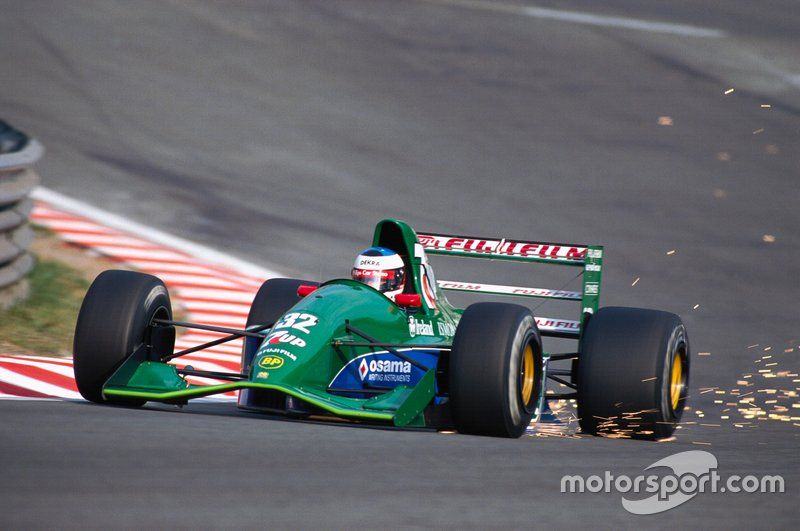
Schumacher’s sensational Spa debut – and blink-of-an-eye tenure at Jordan – now the stuff of F1 legend
Photo by: Rainer W. Schlegelmilch / Motorsport Images
Michael Schumacher’s arrival – as a replacement for the imprisoned Gachot – has passed into F1 folklore and is probably the most famous example of Jordan giving a young driver an opportunity.
Gachot had sprayed a London taxi driver with CS gas and was refused bail to compete at his home GP, so Jordan needed a driver to join de Cesaris.
Many thought Schumacher had raced at Spa before but he hadn’t. The 22-year-old Mercedes sportscar star was nevertheless eighth fastest in his first F1 qualifying session and improved to seventh on Saturday (after Riccardo Patrese was penalised for no operative reverse gear on his Williams). According to Autosport’s Nigel Roebuck, Schumacher drove the 191 “at a rate it had not encountered before”.
Schumacher’s debut was short because his clutch failed on lap one. There are those who think he could have won. Given the drama that unfolded at the front of the field and the fact that de Cesaris was only 3.5s behind an ailing Senna with three laps to go when his engine failed, that’s not as fanciful as it sounds.
But Schumacher had done enough anyway. “It may seem ridiculous already to speak of him as ‘a special talent’,” wrote Roebuck. “But, just once in a while, you get a feeling about a new driver, an impression that this is the start of a major career.”
By the next event, Schumacher was at Benetton and would take the first of his 91 wins at Spa just a year later.
PLUS: Michael Schumacher’s top 10 F1 wins
2. 1999 Italian GP, Monza
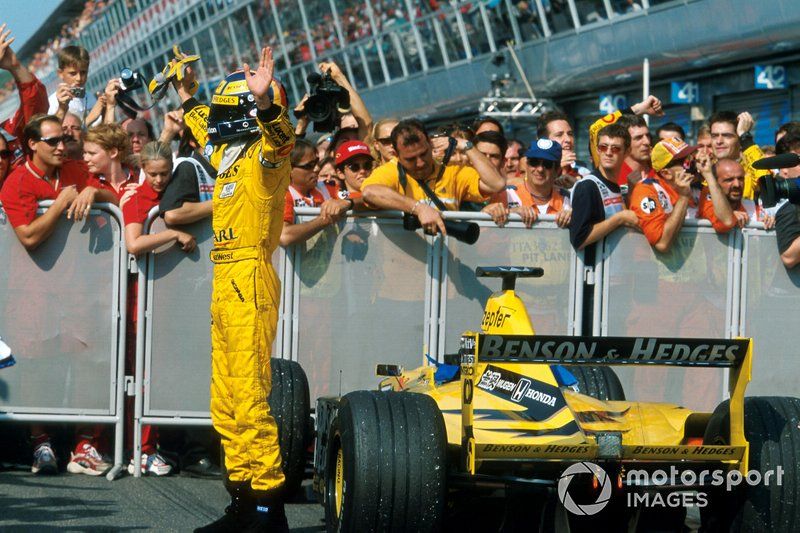
Frentzen’s victory at Monza helped elevate him to world championship contention
Photo by: Sutton Images
This race wasn’t as exciting as the Magny-Cours contest the same year or as dramatic as the 2003 Brazilian GP, but it was the only time a Jordan won a world championship F1 race in the dry. And, for the two weeks between Frentzen’s Monza victory and his 199’s failure on lap 33 of the European GP, it was the one time a Jordan driver genuinely seemed a title contender.
Frentzen qualified second, albeit nearly half a second behind the rapid Hakkinen. Come the race, he ran comfortably ahead of the struggling Ferraris and the McLaren of Coulthard, but leader Hakkinen seemed out of reach, 8s up the road at half-distance.
That was until the Finn selected first gear instead of second and spun off at the first chicane. While Hakkinen walked off to cry in the bushes, Frentzen drove to victory, putting him just 10 points behind Hakkinen and Irvine with three rounds to go.
The race itself was perhaps not as memorable as some on this list, but Frentzen’s emergence as a championship challenger stands as an undoubted high-water mark in Jordan’s history.
“Isn’t it incredible?” said Frentzen. “I can’t believe I have a chance of winning the world title.”
When Frentzen put his Jordan on pole next time out at the Nurburgring, everyone started to wonder what might be possible. He led the race too, but electrical failure put Frentzen out and he eventually finished third in the standings.
1. 1998 Belgian GP, Spa
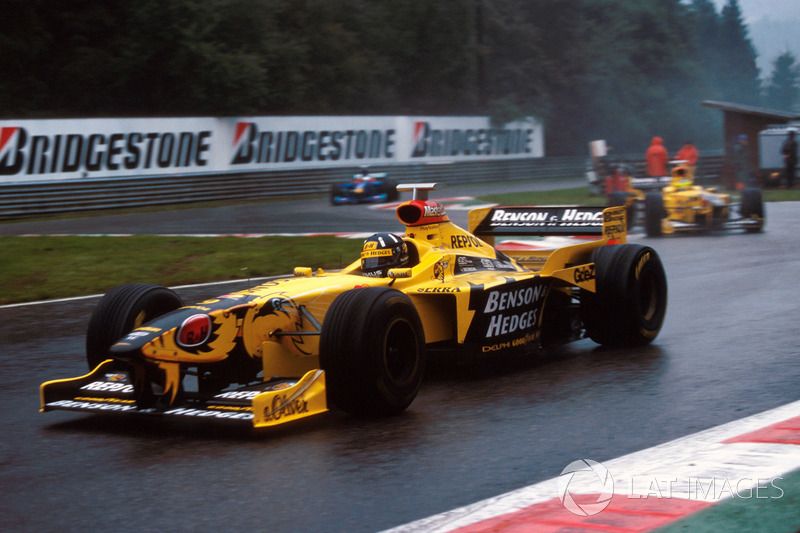
Hill leads team-mate Schumacher ahead of emotional 1-2 finish in tumultuous Belgian GP
Photo by: Sutton Images
Jordan took an emotional first victory in one of F1’s most famous races, on its 127th start and scored a 1-2. It had to top this list.
Despite the arrival of 1996 world champion Hill, Jordan struggled at the start of the new narrow-car/grooved-tyre F1 era in 1998. But the 198 rapidly improved and an inspired Hill qualified third at Spa.
On a wet race day, both Hill and team-mate Ralf Schumacher managed to survive the infamous lap-one crash triggered by Coulthard that led to a restart almost an hour later. Hill grabbed the early lead and, although he succumbed to Michael Schumacher’s Ferrari on lap eight of 44, was soon well clear of the rest.
After the first round of stops, and with 24 laps completed, the Ferrari was 37s ahead of Hill, who had a 10s cushion over Ralf. The second Jordan had climbed the field nicely from eighth on the grid, boosted by an earlier stop to change from intermediate tyres to wets than many of the other frontrunners.
When Michael Schumacher crashed into the back of Coulthard as the Ferrari attempted to lap the McLaren, Hill moved back into the lead. He was 14s ahead when Ralf dived in for his second stop but lost most of his advantage when an unsighted Fisichella smashed into Shinji Nakano and brought out the safety car.
The race restarted with 12 laps to go – and Hill being very firm over the radio about any possibility of his team-mate being allowed to attack. Ralf was told to hold station and Hill duly reeled off the laps to give Eddie Jordan an emotional first win as an F1 team boss.
PLUS: Damon Hill’s greatest drives
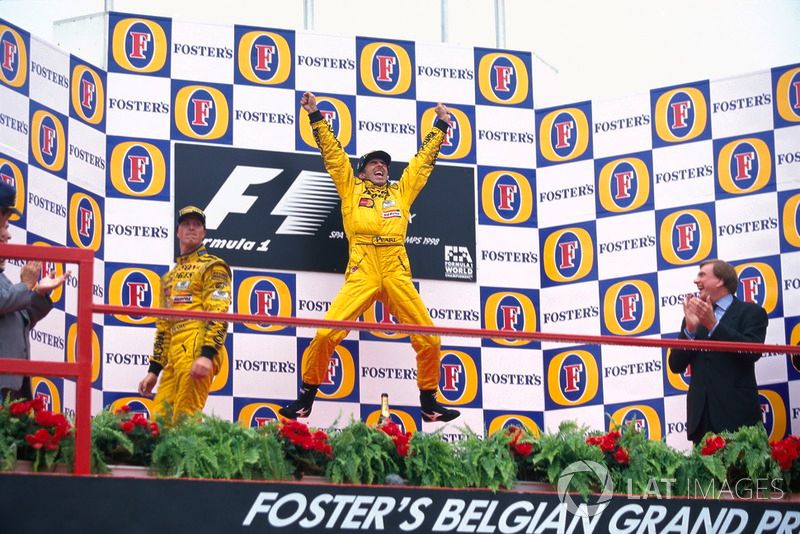
Hill jumps for joy while Schumacher attempts to keep his feelings over Jordan team orders to himself
Photo by: Rainer W. Schlegelmilch / Motorsport Images
In this article
Kevin Turner
Formula 1
Jordan
Be the first to know and subscribe for real-time news email updates on these topics
Subscribe to news alerts
Read the full article here

